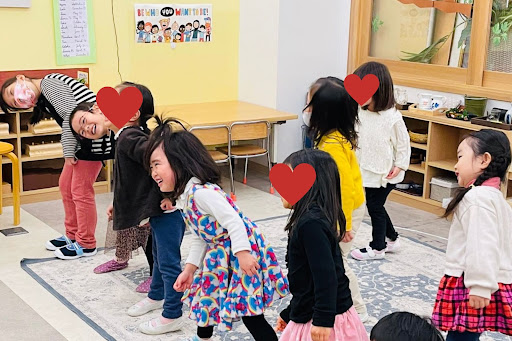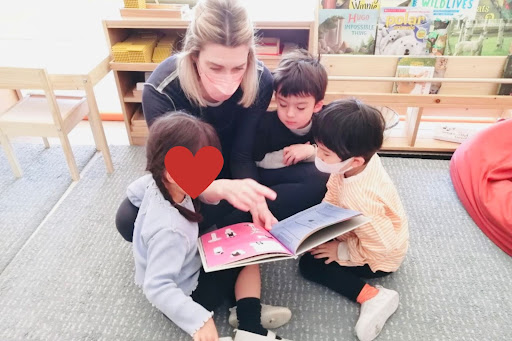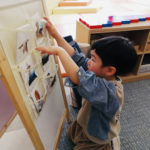
At Ryozan Park Preschool, a number of students come from bilingual or multilingual homes and some speak English only with their family. But the majority of our students are English language learners and speak Japanese as their first language. Some children come to our school without much English experience at all, so we put a large focus on language in our classroom. In this blog post, we will share some of how we support spoken language development in our Montessori classroom.
Unlike in a traditional school where most lessons are taught in a group, the Montessori classroom allows for freedom to choose one’s own activities and more time for one-on-one and small group work. The guides in our classroom speak English at all times, so it is truly an immersive English experience for the child. While working with one child to give a lesson, the guide names the materials in use and involves language to the extent that the activity requires, scaffolding to meet the individual child’s needs and help them grow. For example, when children practice flower arranging in our classroom, the guide introduces them to the names of the flowers available as well as the names of the supplies needed to make the flower arrangement (vase, funnel, pruning shears, etc). In this way, language is introduced naturally. In a small group setting, which we also use frequently, children get a chance to converse not just with the guide but with their friends as well. Some children thrive in this setting and others are more talkative one-on-one. As we go through all the routines of the day, from the morning work cycle, to lunch, to outdoor time, we incorporate as much language as possible. For example, if we have been talking about mushrooms during work cycle time, the guide may show pictures of different mushrooms and ask each child if certain ones are edible or inedible as they invite them to get ready for lunch. Another example would be playing sound games while the children sit on the carpet. The guide may ask, “I am thinking of a fruit that starts with the sound “sss”, do you know what I am thinking of?” A child may answer, “Strawberry!” These types of games not only improve vocabulary but also phonemic awareness and we incorporate them as much as possible to create an English immersive experience.

In our Montessori Kindergarten classroom, we also have monthly language extensions which focus on a particular topic. These topics are chosen based on what the guides have observed the children may be interested in or are new to them. The guides use the language extension topic as inspiration for new activities during that month, usually related to the practical life area. For example, in the month of February, the language extension involved animals and where they live. Children could practice sorting animal cards into their habitats on the board, learn a song about animal habitats, make flags for the countries of Oceania and learn about what animals live there, make a platypus bookmark, and of course, find many books on the topic in our classroom library. These activities are made available to children on our shelves but we don’t force the entire class to complete them on a particular day. It is particularly lovely to see an older child who has completed an activity, for example, the platypus bookmark, show a younger child how to do it. Our discussion of animals and their habitats continues over the course of the month so children get ample time for repeated exposure. We also try to bring back other topics that have been covered in past language extensions as much as possible.

Singing and dancing is an integral part of any early childhood classroom and ours is no different! Every day, just before lunch time, we have a short circle time where we sing songs and practice our dance moves. The activities and length of circle time changes day by day to fit the needs of the children, but most days there is time at least for some song and dance. Adding dance moves and hand motions to match the lyrics of a song is a great way to clarify the meaning of the words to children. In addition to songs, you can also find guides leading the children through tongue twisters, rhymes, and riddles that help improve pronunciation and get their brain thinking. Or if anything, give everyone a laugh!

On any given day in the Montessori classroom, you will find a child reading a book in our library either alone, with a friend, or with a guide. The library is always stocked with beautiful and interesting books for children to get inspired by. A child who is reading a book one-on-one with their guide receives the benefits of direct conversation, the ability to ask questions and get an answer right away, and hearing the words of the story clearly. Oftentimes, when a child reads a book with the guide, they will then read it together with a friend and tell them the story. Even when we read books as a whole class, we often see children rushing to the bookshelf to read the book for themselves a second time the next chance they get.

We hope this gave some insight into how we support spoken English language development in our classroom!







